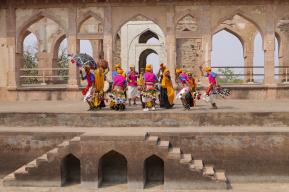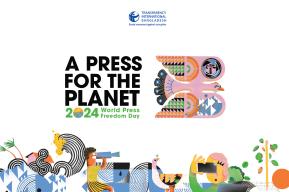News
School-aged pupils and university students join UNESCO environmental DNA sampling in the Sundarbans, Bangladesh

Embracing the heavy chill of January, the eDNA expedition team from Bangladesh set foot on the largest mangrove forest in the world, the Sundarbans, home to the Royal Bengal Tiger. Five sampling locations, reflecting comparative ecosystems, were selected at the Sundarbans West Wildlife Sanctuary, one of the three wildlife sanctuaries in the Sundarbans UNESCO World Heritage area.
Primary school students aged 8 to 12, university-level students, and young teachers took water samples and extracted the eDNA with the use of specialized filtering equipment provided by UNESCO. During the two-day trip, the team witnessed deer, monkeys, wild boar and dolphins, a testimony of the spectacular beauty of the Sundarbans that made a lasting impression on the young students. Prior to sampling, a training session focused on the possibilities of eDNA to monitor and assess the biodiversity of the Sundarbans and precautionary measures required for sampling, in particular to prevent contamination.
eDNA could transform the way we monitor and protect marine biodiversity in the Sundarbans. UNESCO’s initiative is critical to help ensure developing nations have access to the latest innovation and technologies.
The samples are expected to reveal key fish species that live in the area and make up a central part of the Sundarbans’ Outstanding Universal Value. Combined with ocean warming data it makes it possible to gain initial insights on how climate change might influence the distribution of fish species in the Sundarbans. The eDNA sampling expedition was organized with the help of the Bangladesh Forest Department and overseen by Professor Dr. Kazi Ahsan Habib of the Department of Fisheries Biology and Genetics at the Sher-e-Bangla Agricultural University in Bangladesh.
The UNESCO eDNA campaign is being rolled out across 25 marine World Heritage sites between September 2022 and April 2023. The eDNA data is expected to provide a global one-off snapshot of biodiversity richness across marine World Heritage sites, particularly for fish species.
Combined with the Intergovernmental Panel on Climate Change (IPCC) heat scenario projections, the initiative will help inform potential geographic and distribution shifts of fish species as a result of climate change, which are critical for conservation decision-making.
Resulting data will be available at the UNESCO Ocean Biodiversity Information System, the world’s largest open science marine species database. Final results will be available in early 2024.
The UNESCO eDNA initiative is a joint collaboration between the Intergovernmental Oceanographic Commission and the World Heritage Centre. It is made possible with the support of the Government of Flanders (Kingdom of Belgium) and implemented in the context of the United Nations Decade of Ocean Science for Sustainable Development (2021-2030).
About the Sundarbans World Heritage site (Bangladesh)
The Sundarbans was inscribed on the UNESCO World Heritage List in 1997 for its immense tidal mangrove forests and exceptional level of biodiversity. The mosaic of islands, perennially washed by brackish water shrilling in and around the endless and mind-boggling labyrinths of water channels, offers refuge for globally endangered species including the Royal Bengal Tiger, Ganges and Irawadi dolphins, estuarine crocodiles and the critically endangered endemic river terrapin (Batagur baska). It is the only mangrove habitat in the world for Panthera tigris tigris species.






